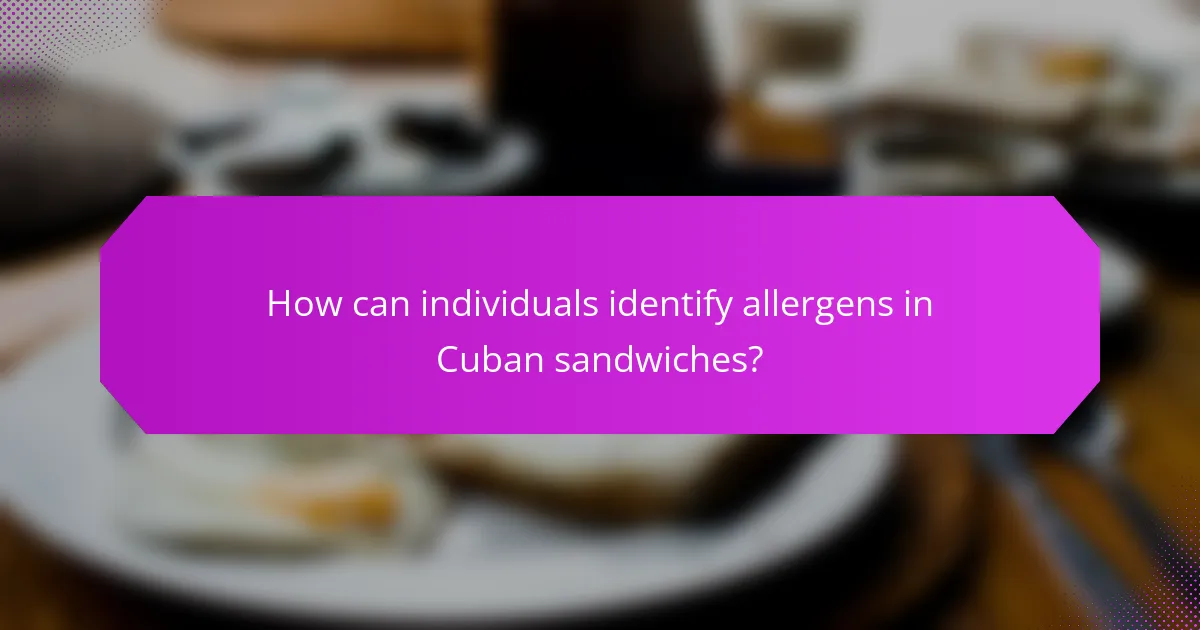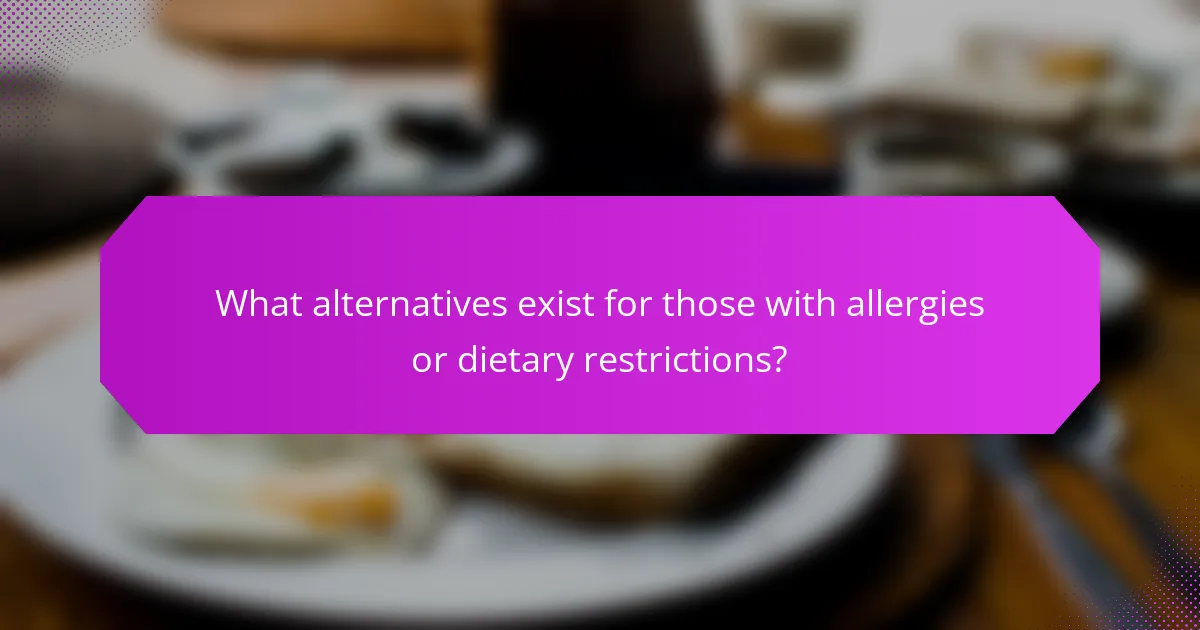Cuban sandwiches are a popular dish in Cuban cuisine, characterized by key ingredients such as Cuban bread, roast pork, ham, Swiss cheese, pickles, and mustard. This article provides essential allergen information related to these ingredients, highlighting common allergens like wheat, pork, cheese, and mustard. It emphasizes the importance of reviewing ingredient lists and asking about cross-contamination risks in restaurants for individuals with food allergies or intolerances. Additionally, the article explores dietary alternatives for those with restrictions, including gluten-free bread, plant-based proteins, and dairy-free spreads, reflecting the growing awareness of diverse dietary needs.

What are the key ingredients in a Cuban sandwich?
The key ingredients in a Cuban sandwich are Cuban bread, roast pork, ham, Swiss cheese, pickles, and mustard. Cuban bread is a soft, white bread that is essential for the sandwich’s structure. Roast pork provides a savory flavor, often marinated in citrus and garlic. Ham adds a salty contrast to the roast pork. Swiss cheese melts beautifully, enhancing the overall taste. Pickles contribute a tangy crunch, balancing the richness of the meats. Mustard adds a zesty kick, tying all the flavors together. These ingredients create a distinctive and popular sandwich, often enjoyed in Cuban cuisine.
How do these ingredients contribute to allergen concerns?
Certain ingredients in Cuban sandwiches can trigger allergen concerns. Common allergens include bread, pork, cheese, and condiments. Wheat in the bread can cause reactions in individuals with gluten intolerance or celiac disease. Pork can provoke allergies in those sensitive to certain meats. Dairy in cheese may lead to reactions in lactose-intolerant individuals or those with a dairy allergy. Condiments like mustard may contain allergens such as soy or eggs. These ingredients pose risks for allergy sufferers, necessitating careful ingredient selection and labeling.
What common allergens are present in the key ingredients?
Common allergens present in the key ingredients of Cuban sandwiches include wheat, soy, and dairy. The bread used typically contains wheat, which is a common allergen. The pork and mustard may contain soy, another frequent allergen. Additionally, cheese, often included in the sandwich, contains dairy, posing a risk for those with lactose intolerance or dairy allergies. These allergens are prevalent in many Cuban sandwich recipes, making awareness crucial for individuals with food sensitivities.
How can ingredient substitutions affect allergen content?
Ingredient substitutions can significantly alter allergen content in food. When a specific ingredient is replaced, the new ingredient may introduce different allergens. For example, substituting wheat-based bread with gluten-free bread can eliminate gluten but may introduce allergens like rice or corn. Additionally, replacing dairy with plant-based alternatives may introduce soy or nuts, which are common allergens. Each ingredient carries its own allergenic potential, which must be considered during substitutions. Research indicates that cross-reactivity can occur, where similar proteins in different foods trigger allergic reactions. Thus, careful evaluation of all ingredients is essential to manage allergen risks effectively.
What dietary considerations should be made for Cuban sandwiches?
Cuban sandwiches contain several dietary considerations. They typically include ingredients like pork, ham, Swiss cheese, pickles, and mustard. Individuals with dietary restrictions should be mindful of allergens such as gluten and dairy. The bread used is usually white bread, which contains gluten. Those with gluten intolerance or celiac disease should avoid traditional Cuban sandwiches. Additionally, Swiss cheese poses a concern for lactose intolerant individuals. The high sodium content from processed meats also requires attention for those on low-sodium diets. Lastly, vegetarians and vegans should seek alternatives, as traditional Cuban sandwiches contain meat and dairy.
How do dietary restrictions influence ingredient choices?
Dietary restrictions significantly influence ingredient choices by limiting options based on health needs. Individuals with allergies must avoid specific allergens such as gluten, dairy, or nuts. For instance, gluten-free bread is essential for those with celiac disease. Similarly, lactose-free alternatives are necessary for individuals with lactose intolerance. Vegan diets exclude all animal products, prompting the use of plant-based substitutes. Health conditions like hypertension may lead to reduced sodium intake, affecting seasoning choices. According to the CDC, food allergies affect approximately 8% of children and 4% of adults, highlighting the importance of accommodating these restrictions in ingredient selection.
What are the nutritional implications of traditional versus modified Cuban sandwiches?
Traditional Cuban sandwiches typically include pork, ham, Swiss cheese, pickles, and mustard on Cuban bread. These ingredients provide a high protein content along with significant amounts of fat and carbohydrates. The traditional version can contain around 500-600 calories per serving.
Modified Cuban sandwiches often substitute ingredients for healthier options. For example, using whole grain bread or leaner meats can reduce calories and increase fiber. Some modifications may also include vegetables, which can enhance the vitamin and mineral profile.
The nutritional implications vary significantly. Traditional sandwiches are higher in saturated fats and sodium due to processed meats and cheese. Modified versions can lower these levels, making them more heart-healthy.
Research indicates that reducing processed meats can decrease health risks associated with cardiovascular diseases. Thus, modified Cuban sandwiches can offer a more balanced nutritional profile while retaining flavor.

How can individuals identify allergens in Cuban sandwiches?
Individuals can identify allergens in Cuban sandwiches by reviewing ingredient lists and asking about specific components. Common allergens in these sandwiches include bread, pork, cheese, and mustard. Reading labels on packaged ingredients is crucial. Additionally, individuals should inquire at restaurants about cross-contamination risks. Many establishments are required to provide allergen information. Understanding common allergens helps in making informed choices. For example, wheat in bread can trigger gluten sensitivities. Identifying allergens is essential for those with food allergies or intolerances.
What labeling practices should consumers look for?
Consumers should look for clear allergen labeling on food products. This includes identifying common allergens such as wheat, soy, dairy, and nuts. Labels should also specify gluten-free or vegan options when applicable. Ingredients should be listed in descending order of weight. Look for certifications like “Certified Gluten-Free” or “Non-GMO Project Verified.” These certifications provide additional assurance regarding dietary claims. Transparency in labeling helps consumers make informed choices about their food. Clear labeling practices can reduce the risk of allergic reactions.
How can cross-contamination occur in sandwich preparation?
Cross-contamination in sandwich preparation can occur when harmful bacteria or allergens transfer from one food item to another. This can happen through shared utensils, cutting boards, or surfaces that have not been properly cleaned. For instance, using the same knife for raw meat and vegetables can lead to the transfer of pathogens. Additionally, if sandwich ingredients are stored together, allergens from one item can contaminate another. Research shows that improper food handling practices significantly increase the risk of cross-contamination. According to the USDA, proper sanitation and separation of food items are essential in preventing this issue.
What are the best practices for ordering Cuban sandwiches safely?
To order Cuban sandwiches safely, first identify any food allergies or dietary restrictions. Communicate these clearly to the staff when placing your order. Request ingredient information to ensure the sandwich meets your dietary needs. Choose establishments that prioritize food safety and hygiene practices. If possible, check online reviews for feedback on food handling. Consider ordering from places that offer customization to avoid allergens. Always confirm that the sandwich is prepared separately from allergenic ingredients. This approach minimizes the risk of cross-contamination. Following these practices helps ensure a safe dining experience.
How can you communicate dietary needs to restaurant staff?
To communicate dietary needs to restaurant staff, clearly state your specific requirements when ordering. Use direct language to describe your allergies or dietary restrictions. For example, say “I am allergic to nuts” or “I follow a gluten-free diet.” This clarity helps staff understand your needs. Additionally, ask questions about ingredients and preparation methods. This ensures that your dietary needs are met safely. Providing written notes or using apps can also facilitate communication. A study by the Food Allergy Research and Education organization shows that clear communication reduces the risk of allergen exposure in dining settings.
What questions should you ask when ordering?
What questions should you ask when ordering? Inquire about the ingredients in the Cuban sandwich. Ask if the bread contains allergens like gluten. Confirm if the meats are processed with any allergens. Request information on the preparation methods to avoid cross-contamination. Check if there are vegetarian or vegan options available. Inquire about the presence of dairy in spreads or sauces. Ask if the restaurant can accommodate specific dietary restrictions. Verify if any side dishes or condiments contain allergens as well.

What alternatives exist for those with allergies or dietary restrictions?
For those with allergies or dietary restrictions, alternatives to traditional Cuban sandwiches include gluten-free bread or lettuce wraps. These options cater to individuals with gluten intolerance or celiac disease. Additionally, plant-based proteins like jackfruit or tofu can replace pork for vegetarians or vegans. For dairy-free diets, avocado or hummus can serve as creamy spreads instead of mayonnaise or cheese. These substitutions maintain flavor while accommodating various dietary needs. Many restaurants now offer these alternatives, reflecting growing awareness of food allergies and dietary preferences.
What are some popular substitutions for traditional ingredients?
Common substitutions for traditional ingredients in Cuban sandwiches include using gluten-free bread instead of Cuban bread. This caters to those with gluten sensitivities. Additionally, turkey can replace pork for a leaner option. Vegan cheese is a popular alternative to traditional cheese for plant-based diets. Mustard can be substituted with avocado spread for a different flavor profile. These substitutions maintain the essence of the sandwich while accommodating dietary restrictions.
How do these substitutions maintain the essence of a Cuban sandwich?
Substitutions maintain the essence of a Cuban sandwich by replicating its core flavors and textures. Traditional Cuban sandwiches feature layers of pork, ham, Swiss cheese, pickles, and mustard. When substitutions are made, such as using turkey instead of pork, the goal is to maintain a similar savory profile.
Using plant-based meats can also capture the essential umami flavors. Vegan cheese can mimic the creaminess of Swiss cheese while ensuring dietary restrictions are met. Additionally, using gluten-free bread retains the sandwich’s structure without gluten allergens.
These alternatives allow for a similar taste experience while accommodating different dietary needs. The essence remains intact through the careful selection of ingredients that echo the original flavors.
What are the benefits of using gluten-free bread or vegan options?
Gluten-free bread and vegan options offer several benefits. They cater to individuals with gluten intolerance or celiac disease, preventing adverse health effects. According to the Celiac Disease Foundation, gluten-free diets are essential for managing celiac disease. Vegan options provide a plant-based alternative, which can lower cholesterol and reduce the risk of heart disease. A study published in the Journal of the American College of Cardiology found that plant-based diets can significantly decrease cardiovascular risks. Additionally, gluten-free and vegan products often contain more fiber and essential nutrients. This can promote better digestive health and overall wellness.
What tips can help ensure a safe and enjoyable Cuban sandwich experience?
To ensure a safe and enjoyable Cuban sandwich experience, consider the following tips. First, check for allergens in all ingredients, including bread, meats, and sauces. Common allergens include gluten, dairy, and soy. Second, communicate dietary restrictions clearly when ordering at restaurants. This helps staff accommodate your needs. Third, ensure that meats are cooked thoroughly to avoid foodborne illnesses. The USDA recommends cooking pork to an internal temperature of 145°F. Fourth, choose high-quality ingredients from reputable sources. Fresh ingredients enhance flavor and reduce the risk of spoilage. Lastly, enjoy Cuban sandwiches in moderation. Balance is key to maintaining a healthy diet while enjoying this dish.
How can meal prep help avoid allergen exposure?
Meal prep can help avoid allergen exposure by allowing for controlled ingredient selection and preparation. When individuals prepare meals in advance, they can choose allergen-free ingredients. This reduces the risk of cross-contamination that can occur in shared kitchens or restaurants.
Additionally, meal prep enables proper storage of food, ensuring that allergens are kept separate. For example, using designated containers for allergen-free meals prevents accidental exposure. Studies show that individuals with food allergies benefit from meal preparation, as it gives them more control over their diet.
Research indicates that 32% of individuals with food allergies report accidental exposure when eating out. By meal prepping, they can significantly reduce this risk.
What resources are available for allergen-friendly dining options?
Allergen-friendly dining options are supported by various resources. Websites such as AllergyEats provide restaurant ratings based on allergen-friendliness. The Food Allergy Research & Education (FARE) organization offers guidelines and resources for safe dining. Mobile apps like “Find Me Gluten Free” help locate allergen-friendly restaurants. Many restaurants now include allergen information on menus. Additionally, local health departments may provide resources and recommendations for safe dining. These resources enhance awareness and accessibility for individuals with food allergies.
The main entity of the article is Cuban sandwiches, which are composed of key ingredients such as Cuban bread, roast pork, ham, Swiss cheese, pickles, and mustard. The article explores allergen information related to these ingredients, highlighting common allergens like gluten, dairy, and soy, and discusses dietary considerations for individuals with restrictions. It addresses how ingredient substitutions can affect allergen content and nutritional implications, as well as best practices for ordering and meal preparation to ensure safe consumption. Additionally, resources for allergen-friendly dining options are provided to assist those with food sensitivities.
